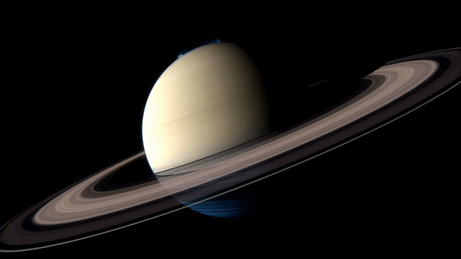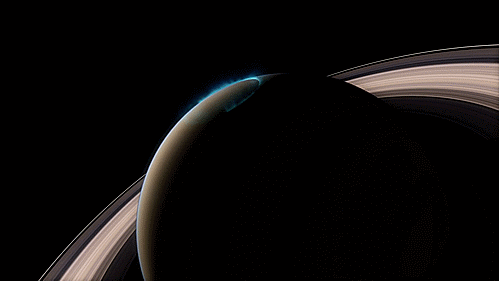Summer Sunflowers.



Summer sunflowers.
Furano, Hokkaido, Japan.
More Posts from Koba-san and Others


This animation shows the fluttering aurorae that light up both of Saturn’s poles. Created by the interaction of the solar wind with the planet’s magnetic field, Saturn’s aurorae are analogous to the more familiar northern and southern light on Earth.
Credit: ESA/Hubble (M. Kornmesser & L. Calçada)


What Is This ‘Cosmic Question Mark’ Captured by the James Webb Space Telescope?
The James Webb Space Telescope has captured a spectacular new image of a pair of actively forming stars about 1,470 light-years away. But beneath the breathtaking phenomenon, some viewers noticed a peculiar shape among the backdrop of celestial objects: a glowing question mark. The image quickly went viral on social media, with jokes about its origin ranging from aliens to a glitch in the Matrix.
The object’s color indicates it is either very distant—billions of light-years away—or much closer and obscured by dust.
The shining question mark represents two galaxies merging. The hooked portion of the shape may be what’s called a tidal tail—a thin, elongated stream of stars and gases that occurs as galaxies interact.
Credit: NASA









🟫Retro Moments🟫

東方Project 博麗霊夢 霧雨魔理沙 Reimu Hakurei Marisa Kirisame
“You need someone that loves your soul more than your body”
— Unknown










~2nd trial is killing me~


Coronal mass ejection
A coronal mass ejection (CME) is a significant release of plasma and magnetic field from the solar corona. They often follow solar flares and are normally present during a solar prominence eruption. The plasma is released into the solar wind, and can be observed in coronagraph imagery.
Coronal mass ejections are often associated with other forms of solar activity, but a broadly accepted theoretical understanding of these relationships has not been established. CMEs most often originate from active regions on the Sun’s surface, such as groupings of sunspots associated with frequent flares. Near solar maxima, the Sun produces about three CMEs every day, whereas near solar minima, there is about one CME every five days.

Coronal mass ejections release large quantities of matter and electromagnetic radiation into space above the Sun’s surface, either near the corona (sometimes called a solar prominence), or farther into the planetary system, or beyond (interplanetary CME). The ejected material is a magnetized plasma consisting primarily of electrons and protons. While solar flares are very fast (being electromagnetic radiation), CMEs are relatively slow.
Coronal mass ejections are associated with enormous changes and disturbances in the coronal magnetic field. They are usually observed with a white-light coronagraph.
Impact on Earth
When the ejection is directed towards Earth and reaches it as an interplanetary CME (ICME), the shock wave of traveling mass causes a geomagnetic storm that may disrupt Earth’s magnetosphere, compressing it on the day side and extending the night-side magnetic tail. When the magnetosphere reconnects on the nightside, it releases power on the order of terawatt scale, which is directed back toward Earth’s upper atmosphere.

Solar energetic particles can cause particularly strong aurorae in large regions around Earth’s magnetic poles. These are also known as the Northern Lights (aurora borealis) in the northern hemisphere, and the Southern Lights (aurora australis) in the southern hemisphere.

Coronal mass ejections, along with solar flares of other origin, can disrupt radio transmissions and cause damage to satellites and electrical transmission line facilities, resulting in potentially massive and long-lasting power outages.
To learn more, click here.
Image credit: Alex Conu
Animation: Science Channel & NASA/Goddard
-
 altheagarden liked this · 1 month ago
altheagarden liked this · 1 month ago -
 rockbirdwoman liked this · 9 months ago
rockbirdwoman liked this · 9 months ago -
 vhagar-balerion-meraxes liked this · 9 months ago
vhagar-balerion-meraxes liked this · 9 months ago -
 bouncehousedemons liked this · 9 months ago
bouncehousedemons liked this · 9 months ago -
 dr-aegon reblogged this · 9 months ago
dr-aegon reblogged this · 9 months ago -
 dr-aegon liked this · 9 months ago
dr-aegon liked this · 9 months ago -
 heretherebebookdragons reblogged this · 9 months ago
heretherebebookdragons reblogged this · 9 months ago -
 rainier-skies liked this · 11 months ago
rainier-skies liked this · 11 months ago -
 rainbowderpturtle liked this · 1 year ago
rainbowderpturtle liked this · 1 year ago -
 pauwa1 liked this · 1 year ago
pauwa1 liked this · 1 year ago -
 dopdopdoop reblogged this · 1 year ago
dopdopdoop reblogged this · 1 year ago -
 yugimoto liked this · 1 year ago
yugimoto liked this · 1 year ago -
 robm74037 liked this · 1 year ago
robm74037 liked this · 1 year ago -
 humorsofwinter liked this · 1 year ago
humorsofwinter liked this · 1 year ago -
 diveintovortex reblogged this · 1 year ago
diveintovortex reblogged this · 1 year ago -
 tiralja liked this · 1 year ago
tiralja liked this · 1 year ago -
 eixei reblogged this · 1 year ago
eixei reblogged this · 1 year ago -
 butterfirefly reblogged this · 1 year ago
butterfirefly reblogged this · 1 year ago -
 ibelongamongthesunflowers reblogged this · 1 year ago
ibelongamongthesunflowers reblogged this · 1 year ago -
 sunflowersforphoenix reblogged this · 1 year ago
sunflowersforphoenix reblogged this · 1 year ago -
 scattered-under-moonlight reblogged this · 1 year ago
scattered-under-moonlight reblogged this · 1 year ago -
 imusyozoku reblogged this · 1 year ago
imusyozoku reblogged this · 1 year ago -
 strawberry022 reblogged this · 1 year ago
strawberry022 reblogged this · 1 year ago -
 holysea reblogged this · 1 year ago
holysea reblogged this · 1 year ago -
 holysea liked this · 1 year ago
holysea liked this · 1 year ago -
 koshigurajumy liked this · 1 year ago
koshigurajumy liked this · 1 year ago -
 psalacanthea reblogged this · 1 year ago
psalacanthea reblogged this · 1 year ago -
 stealthflower reblogged this · 1 year ago
stealthflower reblogged this · 1 year ago -
 c2000jlsm reblogged this · 1 year ago
c2000jlsm reblogged this · 1 year ago -
 nkvictory reblogged this · 1 year ago
nkvictory reblogged this · 1 year ago -
 nkvictory liked this · 1 year ago
nkvictory liked this · 1 year ago -
 enduring-reality liked this · 1 year ago
enduring-reality liked this · 1 year ago -
 thejonderettegirl liked this · 1 year ago
thejonderettegirl liked this · 1 year ago -
 geek-fashionista reblogged this · 1 year ago
geek-fashionista reblogged this · 1 year ago -
 phlash7 liked this · 1 year ago
phlash7 liked this · 1 year ago -
 sunflowersforphoenix liked this · 1 year ago
sunflowersforphoenix liked this · 1 year ago -
 sweaterweatherandlattes liked this · 1 year ago
sweaterweatherandlattes liked this · 1 year ago -
 dandelioninajungle reblogged this · 1 year ago
dandelioninajungle reblogged this · 1 year ago -
 dandelioninajungle liked this · 1 year ago
dandelioninajungle liked this · 1 year ago -
 gaia-aviva reblogged this · 1 year ago
gaia-aviva reblogged this · 1 year ago -
 gaia-aviva liked this · 1 year ago
gaia-aviva liked this · 1 year ago -
 hopesapowerfulthing liked this · 1 year ago
hopesapowerfulthing liked this · 1 year ago -
 xsall liked this · 1 year ago
xsall liked this · 1 year ago -
 categorian-files reblogged this · 1 year ago
categorian-files reblogged this · 1 year ago -
 kuducrow liked this · 1 year ago
kuducrow liked this · 1 year ago -
 anotablequestion liked this · 1 year ago
anotablequestion liked this · 1 year ago -
 ceebee-eebee liked this · 1 year ago
ceebee-eebee liked this · 1 year ago -
 eldadiosabot liked this · 1 year ago
eldadiosabot liked this · 1 year ago



